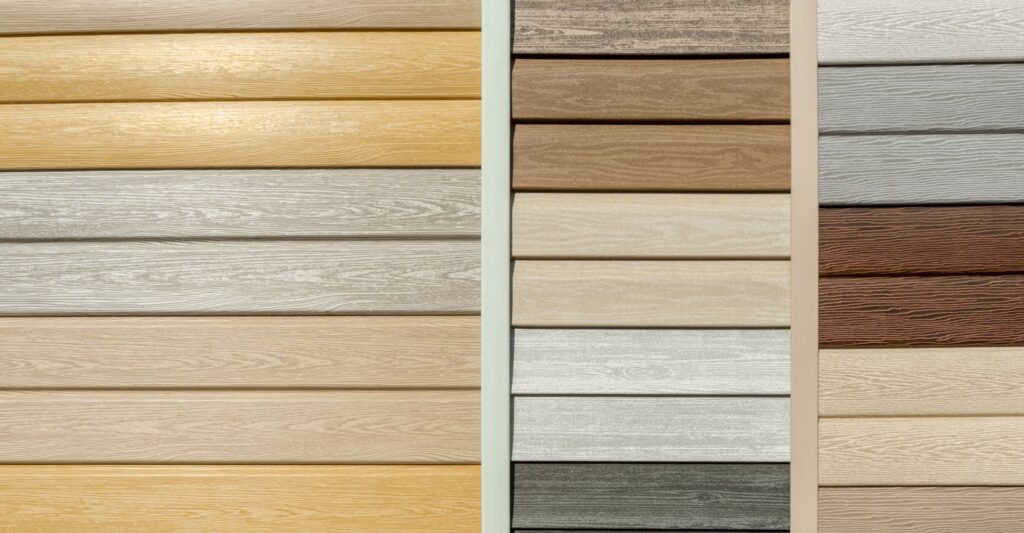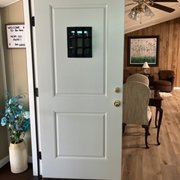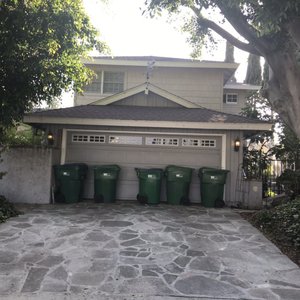
Vinyl siding is an excellent choice for homeowners, providing both functional and aesthetic benefits. Functionally, vinyl siding offers protection from the elements, including wind, rain, and snow. Aesthetically, siding plays a crucial role in a house’s appearance and curb appeal, making it a valuable investment for homeowners.
When choosing the right siding style for your home, there are several factors to consider, such as the architectural style of your home, specific siding needs, material and texture preferences, and budget. Various vinyl siding styles and types are available on the market, each with unique features and benefits.
Clapboard
Clapboard siding is a classic choice that has remained popular for centuries.
Homes with various architectural styles can utilize this type of siding, although it is often associated with Federal Colonial architecture. Clapboard siding consists of narrow, long planks, typically four inches wide. Nail the planks lengthwise, overlapping each other to create subtle shadow lines that add depth and dimension to a home’s exterior.
One of the benefits of clapboard siding is its durability. Made from high-quality materials, clapboard siding can withstand harsh weather conditions, including wind, rain, and extreme temperatures. It is also long-lasting and can maintain its appearance for decades, making it a worthwhile investment for homeowners.
Another advantage of clapboard siding is its low-maintenance requirements. Unlike wood siding, which requires regular staining and painting to maintain its appearance, clapboard siding can be easily cleaned with soap and water. This makes it an ideal choice for homeowners who want to enjoy the beauty of wood without the hassle of regular maintenance.
Clapboard siding presents a versatile option in terms of design, allowing customization to match any architectural style or personal preference. It is available in various colors and textures, allowing homeowners to create a unique look for their homes. With its classic appeal, durability, and low-maintenance requirements, clapboard siding remains popular for homeowners looking to enhance their home’s curb appeal and value.
Dutch Lap
Dutch lap siding is a popular vinyl siding style that adds character and style to a home’s exterior. This type of siding has a distinctive hand-carved look and more striking shadow lines than other siding styles. Dutch lap siding is installed one section at a time, which gives it a unique appearance and makes the overlapping areas appear flatter, creating a more prominent contrast.
One of the advantages of Dutch lap siding is its versatility. This style can be used on homes with a variety of architectural styles, from modern to traditional. It is available in a range of colors and textures, allowing homeowners to customize their home’s appearance to their personal tastes.
Another benefit of Dutch lap siding is its durability. Made from high-quality materials, this siding style can withstand harsh weather conditions and resist fading, cracking, and peeling. It is also low-maintenance, requiring only occasional cleaning to maintain its appearance.
Cedar Shake
Cedar shake siding is a siding style that has a rich texture and color, typically associated with natural cedar. However, natural cedar shake siding can be expensive and requires a lot of maintenance to keep it looking its best. Vinyl cedar shake siding is a cost-effective and low-maintenance alternative with the same aesthetic benefits as natural cedar shake siding.
One of the advantages of vinyl cedar shake siding is its color preservation. Unlike natural cedar, which turns gray over time if not properly stained or treated, vinyl cedar shake siding is designed to retain its original color for years. This siding style is also easy to maintain, requiring only occasional cleaning with a garden hose or pressure washer to keep it looking new.
In addition to its low maintenance and color preservation, vinyl cedar shake siding offers a wide selection of colors. This allows homeowners to customize their home’s appearance to their personal taste and style.
Wood Grain
Wood grain vinyl siding is a popular siding style that mimics the look of natural wood. This siding style is available in various colors and textures, providing homeowners a wide range of options. Wood grain vinyl siding offers the same aesthetic benefits as natural wood but with greater durability and minimal upkeep requirements.
Wood grain vinyl siding offers a long-lasting and low-maintenance alternative to natural wood siding, eliminating the need for regular maintenance to prevent insect damage and rot. Homeowners looking for a siding option that requires minimal upkeep can choose this style, which offers resistance to moisture, termites, and other pests.
In addition to its durability and low maintenance, wood grain vinyl siding is also an affordable option that provides the appearance of natural wood without the associated maintenance costs. This siding style is an excellent investment for homeowners looking to enhance their homes’ curb appeal and value without breaking the bank.
Board-and-Batten
For centuries, board-and-batten siding has been a timeless and traditional option, particularly favored in rural and farm areas. It’s a popular choice for those who prefer a rustic look and want to add a touch of country charm to their homes. You can install this versatile siding style on any architectural style, whether modern or traditional.
Board-and-batten siding comprises wide boards that are spaced evenly and secured to the home’s exterior. The boards are then covered with narrow strips called battens that create a unique pattern and texture on the surface. The battens also help to reinforce the boards, adding strength and durability to the siding.
One of the benefits of board-and-batten vinyl siding is that it’s available in various colors and finishes, allowing homeowners to choose the perfect style to match their home’s exterior. It’s also low-maintenance and can withstand harsh weather conditions, making it a practical and long-lasting option.
You can install board-and-batten vinyl siding horizontally or vertically, depending on your preference. The horizontal installation provides a classic and traditional look, while vertical installation can create a modern and sleek appearance. You can mix this style with other types of siding to create a unique and eye-catching exterior.
Related Content: Vinyl Siding Styles that Can Surely Boost Curb Appeal
Beaded Seam
Beaded seam siding is a vinyl siding style that features a raised seam along the edges of the planks, creating a decorative, beaded effect. Vinyl siding has revived the popularity of this style, which first emerged in the 1800s with the hand-carving of wooden planks.
Beaded seam siding is a great way to add visual interest to a home’s exterior, and it is a popular choice for homeowners who want to boost their curb appeal. The beaded effect creates strong, eye-catching shadow lines that add depth and dimension to the home’s facade. This siding style pairs well with various architectural styles, from traditional to modern.
In addition to its aesthetic appeal, beaded seam siding is a practical choice for homeowners. Vinyl siding is low-maintenance and durable, and the beaded seam style protects against the elements. This siding style is easy to clean and won’t rot or warp over time, making it a long-lasting investment for homeowners.
Each vinyl siding style offers unique features and benefits, making it important to consider your preferences and needs when choosing the right style for your home. Consulting with a trusted and experienced siding contractor can help ensure you select the best siding style for your home. Professional installation is essential if you want to reap all the benefits of vinyl siding, so be sure to choose a reputable contractor to handle your siding installation.


























